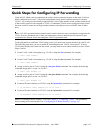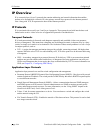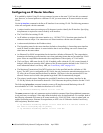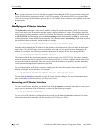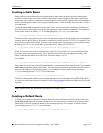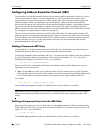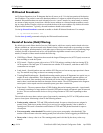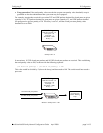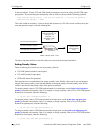
IP Forwarding Configuring IP
page 14-10 OmniSwitch 6600 Family Network Configuration Guide April 2006
Configuring Address Resolution Protocol (ARP)
To send packets on a locally connected network, the switch uses ARP to match the IP address of a device
with its physical (MAC) address. To send a data packet to a device with which it has not previously
communicated, the switch first broadcasts an ARP request packet. The ARP request packet requests the
Ethernet hardware address corresponding to an Internet address. All hosts on the receiving Ethernet
receive the ARP request, but only the host with the specified IP address responds. If present and function-
ing, the host with the specified IP address responds with an ARP reply packet containing its hardware
address. The switch receives the ARP reply packet, stores the hardware address in its ARP cache for future
use, and begins exchanging packets with the receiving device.
The switch stores the hardware address in its ARP cache (ARP table). The table contains a listing of IP
addresses and their corresponding translations to MAC addresses. Entries in the table are used to translate
32-bit IP addresses into 48-bit Ethernet or IEEE 802.3 hardware addresses. Dynamic addresses remain in
the table until they time out. You can set this timeout value and you can also manually add or delete
permanent addresses to/from the table.
Adding a Permanent ARP Entry
As described above, dynamic entries remain in the ARP table for a specified time period before they are
automatically removed. However, you can create a permanent entry in the table.
Use the arp command to add a permanent ARP entry. You must enter the IP address of the entry followed
by its physical (MAC) address. For example to create an entry for IP address 171.11.1.1 with a corre-
sponding physical address of 00:05:02:c0:7f:11, you would enter:
-> arp 171.11.1.1 00:05:02:c0:7f:11
When you add an entry to the table, the IP address and hardware address (MAC address) are required.
Optionally, you may also specify:
• Alias. Use the alias keyword to specify that the switch will act as an alias (proxy) for this IP address.
When the alias option is used, the switch responds to all ARP requests for the specified IP address with
its own MAC address. Note that this option is not related to Proxy ARP as defined in RFC 925.
For example:
-> arp 171.11.1.1 00:05:02:c0:7f:11 alias
Use the show arp command to display the ARP table and verify that the entry was added.
Note. Because most hosts support the use of address resolution protocols to determine and cache address
information (called dynamic address resolution), you generally do not need to specify permanent ARP
entries.
Deleting a Permanent Entry from the ARP Table
Permanent entries do not age out of the ARP table. Use the no arp command to delete a permanent entry.
When deleting an ARP entry, you only need to enter the IP address. For example to delete an entry for IP
address 171.11.1.1, you would enter:
-> no arp 171.11.1.1
Use the show arp command to display the ARP table and verify that the entry was deleted.




